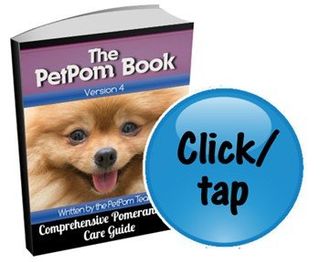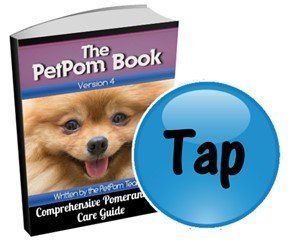Skin
PetPom

The
Pomeranian
Information
Center
Pomeranian Skin Problems
Overview
This breed, among many others, can be prone to a wide variety of skin problems. There is a direct correlation between healthy skin and a healthy coat, so if your Pom has dry skin or other issues, it is most likely affecting the fur as well.
We will discuss:
- Dry and Flaky Skin
- What You Can Do to Treat This
- What Not to Do
- Allergies that cause skin problems
- How Certain Grooming Techniques can Make a Huge Difference
Dry Skin Issues
One of the most common, yet frustrating issues is Pomeranian dry skin. The symptoms can be one or a combination of the following:
- Obvious signs of peeling and flaking
- Flakes are falling off onto the coat (dandruff)
- Area(s) of white or pink skin that is rough to the touch
- Redness
- Swelling
- The dog has a tendency to chew at or nibble at the site
- This can be all over the body or it can be only on certain areas
Note:
If you noticed a very bad smell this will point to a different issue, that you can read about in the Pomeranian odor section.
Reasons that Dry Skin Develops & Fixes
1) Blocked air flow.
Since this breed has a very thick double coat, consisting of both a dense inner layer and an outer layer of longer guard hairs, the coat can form a sort of barrier which can prevent fresh air from reaching below to the skin. If you add to that some shedded hairs that have fallen back into the coat, you have a recipe for dry skin. Hairs are mixing with body oils and are trapped on the skin and the coat is so thick that air is not reaching the area to offer any help.
Be sure to routinely brush the coat not just for appearances, but to purposely pull out shedding fur. Using a quality slicker brush sized for toy breeds will work well for the Pom. Use a sweeping motion, of down, through and out. It is important to feel that you are reaching the skin without using so much force as to cause discomfort. As you sweep out, look at the brush and see if it has caught dead hairs. If not, you will need to practice brushing deeper.
Routine grooming in this way should be done every 3 days or so. If an owner allows too many days to pass in-between sessions, this is what causes the block of air flow which is needed for health skin…And it will lead to matting and additional problems.
2) The wrong products. Anything that goes onto your Pom's coat also goes onto his skin and cheaper products including shampoo, conditioner and leave-in sprays that have the wrong PH balance can ruin a coat and dry out the skin.
3) Bathing techniques.
Another element that also contributes to Pomeranian skin problems is improper bathing techniques. Even with the right shampoos and conditioners, if the product is not properly rinsed out, tiny particles of it will cake up on the skin. This then clogs skin pores and blocks healthy skin circulation. When you think you've rinsed enough, go over the coat one more time. Be sure to use luke warm water and using a nozzle is always best. In addition, too many baths can dry the skin out. Baths should be given once every 3 weeks.
4) Static and dry air.
When the air is dry, this can dry out a Pom's skin and his fur. Arid air is much more common in the winter than during warmer months, however depending on where you live this can be a year-round problem. It can always help to increase the humidity in your home and the best way to protect the skin is to use a leave-in spritz that is distributed on the coat from roots to ends. The fur will then protect the delicate skin underneath.
5) Too much blow drying.
If you blow dry your Pomeranian after baths, this can cause issues ranging from dried out skin to a frizzy coat. Air drying is best after scrunching fur with absorbent towels to soak up most of the water. If you must blow-dry your Pom, so this on a low-heat setting and hold the dryer at least 4 or 5 inches from your dog.
Allergies and Skin Issues
Allergies can manifest as skin issues including hot spots of sore red spots and itchy skin. In some cases it can be so severe that there is hair loss. This can happen if a Pomeranian chews or scratches at an area or if the skin is so badly damages that hair follicles are affected. Usually it would be accompanied by other symptoms including but not limited to:
- Nasal and/or eye discharge
- Congestion or runny nose
- Red, irritated eyes
- Coughing
- Upset digestive system (sometimes with food allergies)
It's important to point out that many owners do not believe allergies to be the cause of skin problems if the Pom didn't have previous issues. However, a dog can grow into (or out of) allergies, just as humans can. Therefore, no matter what the age of your Pom, this should be considered as a possible cause.
It may seem logical that if the skin is erupting, that the dog must be allergic to something he is touching, however while a possible cause both food and inhaled triggers can also cause the skin to react.
Allergies can include:
- Food - Note that this includes food additives. It is artificial coloring, artificial flavoring and chemical preservatives that most dogs are allergic to, not an actual 'real' food ingredient.
- Contact allergies - Skin can dry out, crack open afterward and develop red sore spots from a trigger that the dog comes into contact with. This includes but is not limited to lawn care chemical, ice melt chemicals on roads in the winter (and also in the spring as they melt along with the snowbanks), carpeting, carpet cleaner, detergent that has been used to wash bedding and more.
- Inhaled trigger - If a Pom is having a reaction to pollen, weeds and other seasonal allergies, dry cracked skin is one of the symptoms.
What you can do:
1) Have this diagnosed.
Certainly work with your dog's veterinarian to pinpoint the allergens that are affecting your Pomeranian. Many treatments including prescribed anti-inflammatory medications, antihistamines, corticosteroid and even shots can help control itching and other issues.
2) Allow the Pom's body to rest.
If a reaction to an ingested element is suspected, put your Pom on a bland diet of ONLY plain chicken (no bone, no skin) and either sweet potato or white rice. Do not add any spices other than a dash of salt. Giving this, with no other foods, for 2 to 3 weeks can let the body rest.
A dog's body needs this amount of time for the toxin to be cleansed from the body and for inflamed skin to calm down. In you see an improvement, you'll know that the cause was something your Pom was eating. Staying on a home cooked diet may be the answer for you - add plenty of veggies, fruits and extras like cottage cheese and whole white yogurt. Or you may wish to switch food to an organic, hypoallergenic formula.
3) Offer cooling and soothing baths with an oatmeal based products that will offer relief to itchy skin and sore spots.
4) Keep an eye out for skin that is so dry that it cracks open; once this happens it is vulnerable to infection that would need to be treated with antibiotics.
5) Use a deep moisturizing skin rescue lotion every day. *** Recommendations for itchy skin relief is found on the Pomeranian Itchy Issues
page.
6) Cover sensitive skin. Any areas of sore skin that can be covered up
with a light cotton shirt, should be covered. If you can't cover your Pom, lie down a soft baby blanket and be sure that it has first been washed with hypoallergenic laundry detergent and preferably hot-air dried with a scent-free static cling sheet.
7) Filter the water that your Pomeranian drinks.
In the majority of locales tap water can legally contain some horrifying elements that have been proven to cause everything from cancer to thyroid problems and so much more. Use a quality filter on your kitchen tap or obtain a canine water fountain system with replaceable charcoal filters.
8) Omega 3 can help.This supplement can provide great relief for Pomeranian with dry skin conditions. This should be given each day for 3 weeks to see improvement and with continued use, the dry skin may go away completely. Some people recommend adding olive oil to meals, however with Omega 3, it is not necessary.
9) Do not use avocado. We have seen several sites that advise owners to add avocado to the diet. This is dangerous. While they do contain healthy fatty acids the ingestion of this food can be dangerous to small animals, the Pomeranian included.
10) Work with the vet.
Be sure to stay in contact with your dog's veterinarian to revisit the issue if the skin does not clear up.
See also:
When a Pom is a finicky eater
- A good article for owners who have a Pom that resists eating meals.
Pom is eating cat food
- Find out if this is unhealthy and steps you can take to help keep your canine out of your feline's dinner dish.
Winter care for a Pomeranian
- With harsh cold weather comes a some important grooming changes.
Pomeranian heat cycle
- If you have an un-spayed female, you'll want to learn all about the heat cycle for this little toy breed dog.
If you email photos to us, you agree that PetPom is given free copyright to use at our discretion. We will always credit the photo to the name of the Pom's owner(s) if it is supplied.
Email: Contact@PetPom.com
All text, images and artwork protected by US and International copyright laws. All rights reserved. Copyright PetPom.com
We are a participant in the Amazon Services LLC Associates Program, an affiliate advertising program designed to provide a means for us to earn fees by linking to Amazon.com and affiliated sites.


